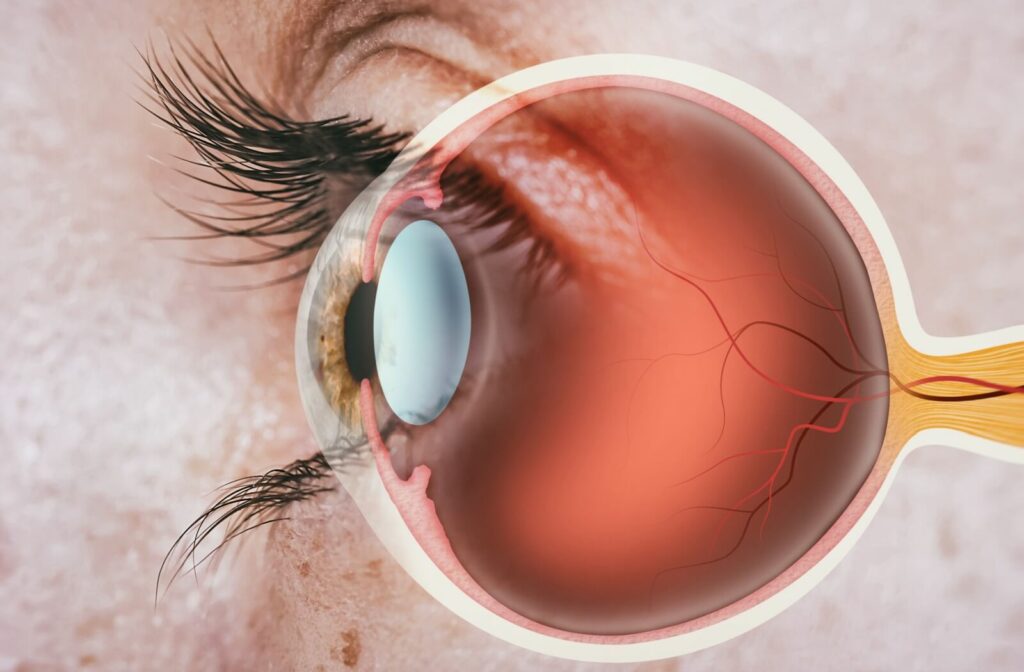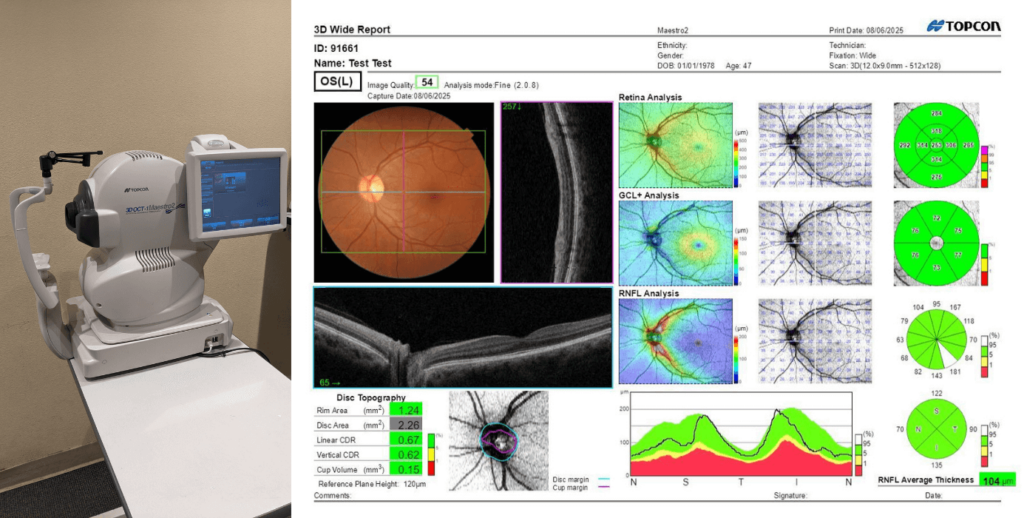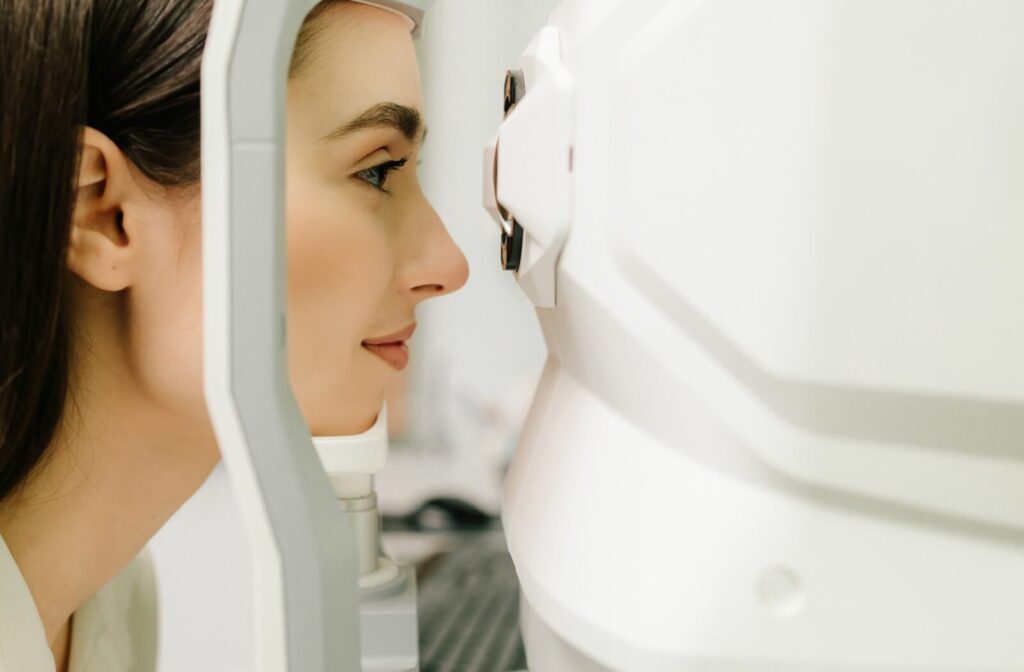Thanks to modern technology, we can see more of the eye without resorting to invasive techniques. One such technology eye care professionals use to detect serious eye diseases is optical coherence tomography (OCT).
Optical coherence tomography uses light waves to create cross-sectional images of the back of your eye. It works in a comparable way to ultrasound and allows eye care professionals to detect or monitor the progression of eye diseases like glaucoma, macular degeneration, and diabetes-related retinopathy.
Wondering whether an OCT eye test is right for you? Talk to your optometrist at your next regular comprehensive eye exam.
What Is Optical Coherence Tomography (OCT)?
Optical coherence tomography (OCT) allows eye care professionals to create 3-dimensional cross-sectional images of the eye. Infrared light wavelengths are reflected off the retina at the back of your eye and measured to create detailed images of your eye. Your retina contains light-sensitive cells that relay signals to your brain through the optic nerve, helping you see.
OCT allows eye care professionals to see the layers that make up the retina and optic nerve. Measuring and monitoring changes in these layers helps track the progress of diseases and eye health. And thanks to OCT technology, all this can be performed without surgical intervention.
What Diseases Can Be Detected By an OCT Eye Test?
By giving them access to your retina and optic nerve, an OCT eye test can help an optometrist diagnose diseases like:
- Macular degeneration: This is a fairly common age-related condition that affects central vision. There are two types, “wet” and “dry,” and while there is no cure, treatments are available to slow the disease’s progression.
- Diabetes-related retinopathy: In some people with diabetes, the blood vessels in the retina are weakened; this may even lead to vision loss. However, not everyone with diabetes will develop diabetes-related retinopathy.
- Glaucoma: This eye disease can lead to vision loss due to a damaged optic nerve. It’s associated with high eye pressure, but some people with high eye pressure don’t develop glaucoma, and there’s a type of glaucoma that happens to eyes with normal pressure.
- Retinal detachment: Your retina is located at the back of your eye and contains light-sensitive cells. Retinal detachment happens when the retina falls away from the eye. It’s a sight-threatening condition that’s considered a medical emergency.
- Some cancers: Cancers of the eye are considered to be very rare. Types of eye cancer include intraocular melanomas, eyelid and orbital cancers, retinoblastoma, and intraocular lymphoma.
Who Needs an OCT Eye Test?
You may be recommended an OCT eye test if you have symptoms of certain eye diseases, which may be identified during a routine eye exam. Your medical history and age may also put you at higher risk of certain diseases; in which case, an OCT eye test to monitor your progress may be appropriate.
Think you could use OCT test? Talk to your optometrist. Make sure to share your personal and family medical history, as this information tells your optometrist what diseases you may be at higher risk for.

What Happens During an OCT Eye Test?
An OCT eye test is a relatively simple procedure. The only thing that touches your eye is eye drops that dilate your pupils, if your optometrist chooses to use them.
After dilation, you’ll be seated in front of a scanning machine with a place to rest your chin and stay still. The machine will then take pictures of your eye. You’ll be asked to focus on a green target, and you may see a red line during the scanning process. The entire procedure should take 5 to 10 minutes.
Are There Side Effects?
Because OCT involves pupil dilation, you can experience temporary side effects such as blurry vision, sensitivity to light, and headaches. This can affect your ability to drive, so ask your optometrist whether you should make transportation arrangements to take you home after your appointment. Side effects associated with pupil dilation generally only last a few hours.
OCT Eye Test vs. Regular Eye Exams
Regular comprehensive eye exams are important for everyone, including those with healthy vision, because eye exams can screen for diseases before they become apparent.
While regular eye exams measure things like visual acuity (how well you see at various distances), ocular motility (how your eyes move), depth perception, and color perception, OCT tests go a step further. OCT technology allows your optometrist to get an up-close, in-depth look at the structures in your eye, giving valuable insight into your eye health.
Sometimes, OCT tests happen after a regular eye exam, such as when findings during an exam provoke more in-depth testing. If you’re curious about optical coherence tomography, talk to your optometrist during your next eye exam. Your optometrist should prioritize your health and explain why and what tests they recommend performing.

Ask Us About Optical Coherence Tomography
Our team at Optometry Group of Fontana, Upland and Rancho Cucamonga believes in quality eye care with a personal touch. We strive to tailor our services to each patient’s unique needs and believe in empowering our patients with education and insight into their eye health. We use advanced imaging technology like the Topcon Maestro2, a 3D OCT and fundus camera, to perform detailed OCT eye tests for early detection and monitoring of eye conditions. If your condition requires further assessment, we also work closely with trusted ophthalmologists for referral care.
According to the American Optometric Association (AOA), most adults ages 18 to 64 benefit from a comprehensive eye exam every two years. Those at increased risk of certain diseases may require more frequent exams. If you’re due for yours, contact us today to book an eye exam at one of our locations in Fontana, Upland, or Rancho Cucamonga.


